General Comfrey Plant Information
Grow Comfrey
"Your site
is very educational and helped me gain an appreciation for comfrey." -Tony,
ToDoListHome.com. YouTube video showing Nantahala Farm Comfrey
Roots.
"Thank you for educating us through your website. I know it takes much time to curate this information and put it out there in a form that can be easily understood by the rest of us who have not been studying these comfrey plants as you have done." -Lisa, Bishop, Georgia
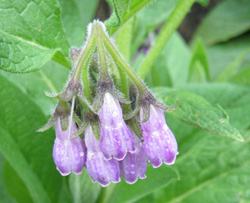 |
Comfrey:
Legendary Herb of Life
Comfrey is
high in protein: 22-33%. High in vitamin A, C and B-12. Rich in silicon,
calcium, potassium, phosphorus, iron, iodine and more.
Very high food value for animals such as goats, cattle, sheep, horses, pigs,
chickens, and ducks. Used as a folk remedy for thousands of years. Known
as boneset and knitbone.
|
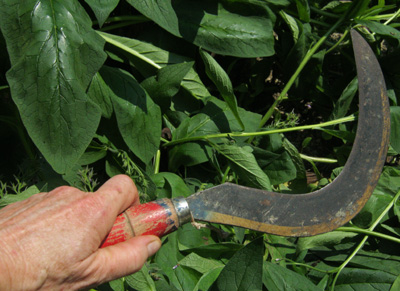
|
Comfrey
Increases Fertility of Soil
Comfrey is
superb for improving your soil. It can be used as compost material for organic
gardens.
It is very deep rooted so it mines many nutrients from the soil.
The fast growing leaves contain these nutrients. When you cut the leaves,
they quickly break down to a thick, black, fertile liquid great for your
garden.
|
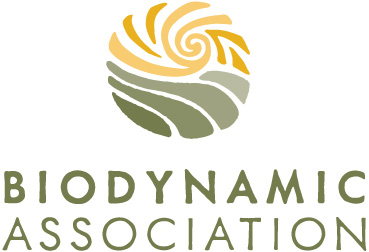 |
Permaculture
and Biodynamics
Since Comfrey
is a valuable perennial, it is popular in Permaculture for ecological farming
systems that benefit both land and people. Permaculture is defined as "the
development of agricultural ecosystems intended to be sustainable and self-sufficient."
Dr. Rudolf
Steiner, father of Biodynamic Agriculture, lists these 7 plants as being
very important on a farm: comfrey,
Stinging Nettle,
Yarrow,
chamomile, horsetail,
dandelion and valerian. Others have added burdock to the list.
|
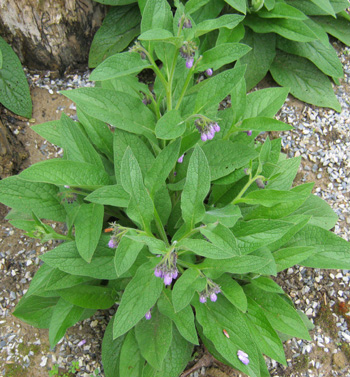 |
Comfrey
(Comphrey, Compfrey, Cumfrey)
Comfrey (Boraginaceae
family; Symphytum genus) has large, hairy leaves up to 10 inches long. Russian
comfrey grows 4 feet tall. True/Common grows 3 feet tall.
The flowers are small, bell-shaped either white, blue, purple, yellow, magenta,
or pink. They start blooming in April or early May and continue to bloom
for most of the summer.
Russian comfrey (Symphytum x uplandicum) is sterile so it will not reproduce
through seeds. True/Common Comfrey (Symphytum officinale) does reproduce
by seeds.
|
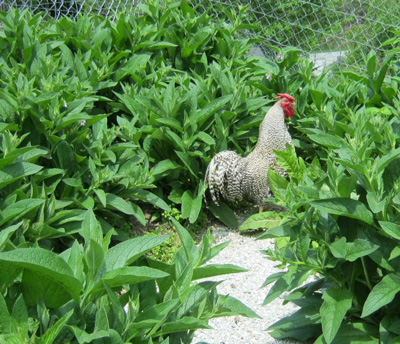
|
Comfrey:
High Yield Perennial
Comfrey is
a perennial that is very prolific in all climates. It does well in clay,
light sands, and loams. It can be planted at any time of the year that the
ground is not frozen.
Comfrey's fountain of large dark green leaves make a wonderful addition
to your landscape. The flowers are showy and beautiful.
"I ordered the comfrey for my chickens. Just retired and wanted to try chickens again with more time to care and play with them. An old friend of mine always touted the benefits of comfrey for her fowl. I so much appreciate the information you included with my order (some heritage seeds as well). You do a service educating the gardener!" -Penny, Maryville, Tennessee
|
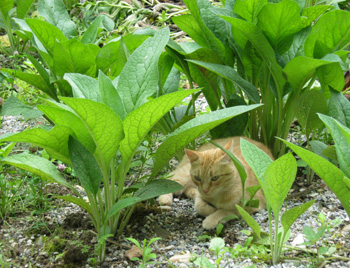 |
Comfrey Cultivation
and Care
Comfrey grows
well in USDA Hardiness Zones 3-9. Comfrey does well in full sun or partial
shade. In very hot climates partial shade can be better.
Plant root cuttings several inches deep with the root sitting horizontally.
It likes fast draining soil. Do not overwater. You can kill plants if the soil is always wet. Let soil dry out between watering. Comfrey roots rot if there is too much water.
Plant Russian Comfrey (Symphytum x uplandicum) about 3 feet apart in each
direction. Plant True Comfrey (Symphytum officinale) about 2 feet apart.
|
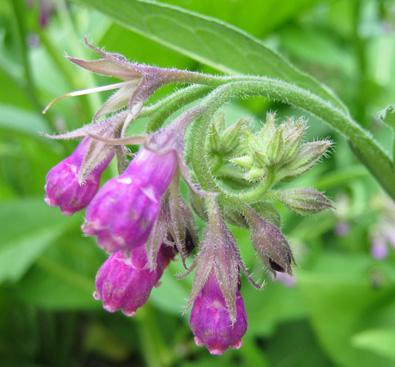
| Comfrey
Fertilization and Maintenance
It is best
to dig in manure between the rows in the fall or spring. Raw manure will
not burn it. Comfrey loves nitrogen. You will get a lot more yield.
You can remove flower buds when they appear since they take a lot of the
plant's energy to produce. However, bees and other beneficial insects love
the flowers so I like to leave some flowers for them.
|
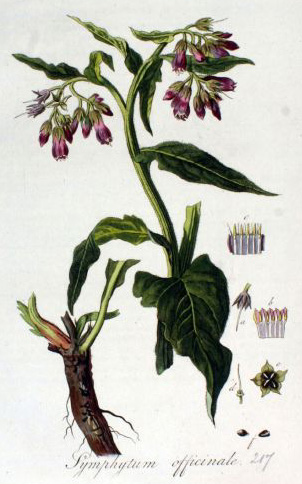
|
Easy
to Grow
If you receive comfrey roots and your ground is frozen, fill some gallon or larger pots with potting soil. Plant 1 or several in the pot. Keep in window inside, or put in greenhouse/coldframe outside. Keep well watered. If you can't plant right away, you can keep them in the refrigerator (not freezer) for a few days.
Comfrey is easy to grow and has few diseases or pests. Harvest leaves from the plant throughout spring, summer and fall. Do not harvest late fall so the plants can store up energy for the winter. You should get at least 3 cuttings a year, sometimes even 6.
|
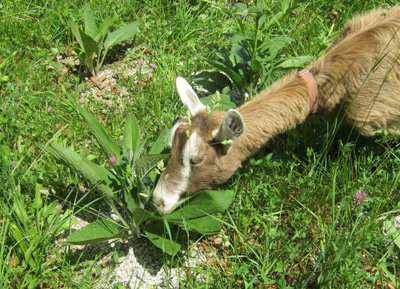 |
Livestock
Love Comfrey
This photo
with the goat shows how it was planted in a pasture. These are young plants.
A small area was cleared of weeds and one comfrey root was buried. While
it was developing, the area was kept weeded. Once the plant is established,
you don't have to weed around it any more.
|
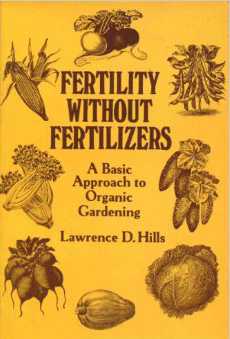 |
Comfrey
Books by Lawrence D. Hills
Lawrence Hills
wrote 3 important books on comfrey (see below) as well as books on organic
gardening and natural fertilization. The gardening books include "Fertility
Without Fertilizers", "Organic Gardening", "Grow Your
Own Fruit & Vegetables", and "Fighting Like Flowers".
Unfortunately, none of the below comfrey books are still in print.
|
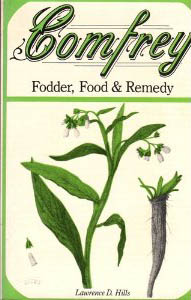
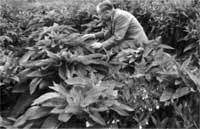 |
Comfrey:
Fodder, Food and Remedy
The
book "Comfrey: Fodder, Food and Remedy" by Lawrence D. Hills is highly recommended.
It was published 1976. Mr. Hills is the world's leading expert on comfrey. He
discusses how to properly cultivate comfrey so you enjoy its benefits. The protein
yield per acre from comfrey is almost 20 times that of soybeans. Dairy animals
produce high quality milk. It is high in potassium, Vitamin A and Vitamin B-12.
The book "Comfrey: Past, Present and Future" by Lawrence D. Hills is the
exact same book as the above book. The only difference is that the second book
is a poor reproduction (photocopy) of the first book. The photos are not as good
quality. It was published 2009.
The black and white photo is Lawrence Hills working in a field of comfrey.
|
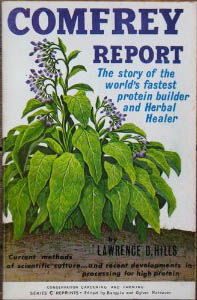 |
Comfrey
Report
Another
book by Lawrence Hills is the "Comfrey Report: The Story of the World's Fastest
Protein Builder and Herbal Healer" (Conservation gardening and farming series:
Series C, Reprints).
It was printed in 1975. It contains "current methods
of scientific culture and recent developments in processing for high protein".
|
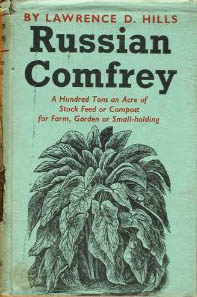 |
Russian
Comfrey Book
"Russian Comfrey: A Hundred Tons an Acre of Stock or Compost for Farm, Garden
or Smallholding" by Lawrence Hills is an excellent book. It was printed in
London in 1953.
It covers the history and use of comfrey in Great Britain. It is full of
information about how to grow and harvest comfrey. And then feeding it to
livestock or making compost. One farmer planted 1/4 acre of Russian Comfrey
that provided enough food for 3 cows and 2 horses.
|
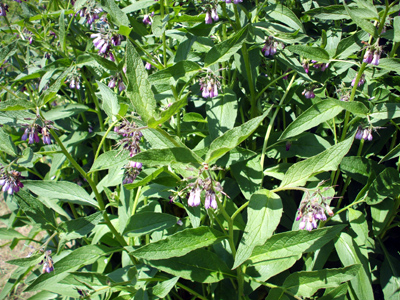 |
Comfrey
Plants
This photo taken by Ray is comfrey at 3,000 feet elevation in Greenwood, British Columbia, Canada.
|
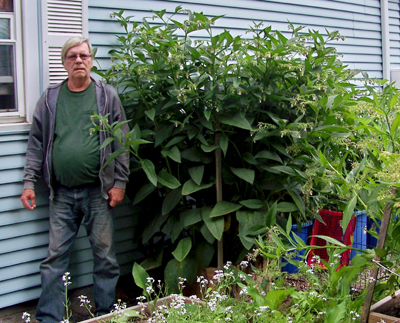 |
6 Foot
Tall Comfrey Plants
This photo
is from Richard in Voorheesville, New York (grow zone 5B). He is 6 feet tall.
|
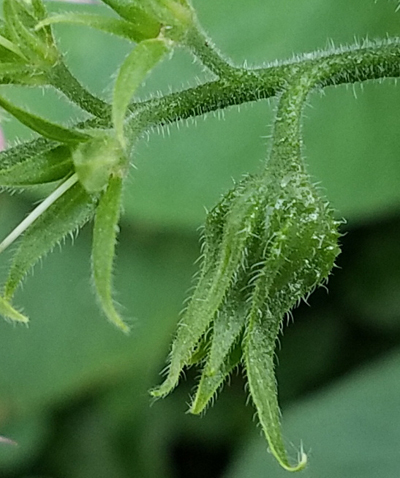
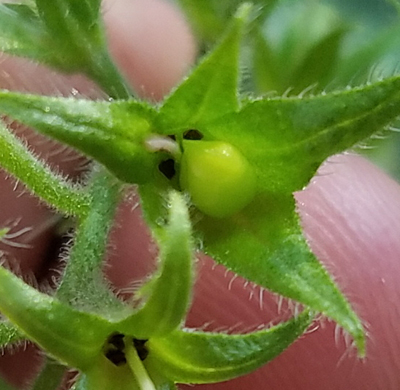
|
Comfrey
Flower Pods
These 2 photos
are after the flower petals have fallen off. You can see the seed developing.
Notice how prickly Comfrey is.
Thank you to Pat for great photos.
|
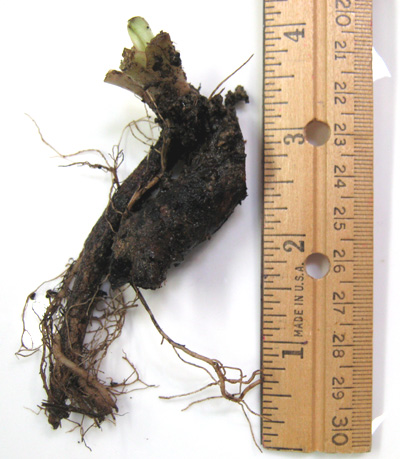
|
Buy Live
Comfrey Roots for Planting
Grow
your own Comfrey: True/Common Comfrey, Russian Bocking #4, Russian Bocking
#14, Symphytum Hidcote Blue.
Your order includes a flyer about how to take care of your plants.
Comfrey
Easy Order Page
|
| |
|
















